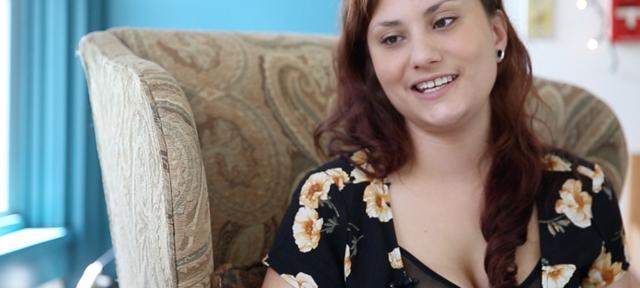Division III Profile: Emma Pici-D'Ottavio On Art Therapy

Right from the beginning of her Hampshire career, Emma Pici-D’Ottavio knew she wanted to combine her passions for art and psychology to become an art therapist. She followed through on that goal in her final year, with a Division III project that documented the benefits of the visual arts in treating depression.
As part of her research for her thesis, Pici-D’Ottavio held a workshop in her mod apartment for 23 of her peers and asked participants to use the technique of “blind” contour drawing, in which the artist looks at the paper only for points of reference and concentrates on the subject reflected in a mirror rather than the line being put to paper. Under her instruction, the group created self-portraits that reflected an emotional time—positive or negative—in their lives.
Pici-D’Ottavio cites Elizabeth “Grandma” Layton as an influence. Layton had long sought treatment for depression, in a variety of ways, with no success until age 68, when she began to pursue art. Her art and subsequent recovery from a lifetime of depression caught the eye of the art therapist Robert Ault, who transcribed Layton’s work into a form that could be taught to artists and non-artists, which Pici-D’Ottavio also used for her research and thesis. In fact, Layton created the self-portrait drawing exercise Pici-D’Ottavio implemented in her workshop.
Many of the pieces resulting from Pici-D'Ottavio's workshop spoke to health issues, relationship problems, and mental-health challenges that were given light through the work. “This exercise is helpful for people with depression,” she explains, “because they often adapt a more negative view of themselves and their environment, and connecting with reality in this positive way kind of helps refute their negative self-image.”
“Before and after the drawing exercise,” she says, “all participants filled out a set of questionnaires with rating scales that are typically used in psychology research to measure current mood and evaluations of self. Afterward, participants completed a questionnaire to assess their perception of the exercise, including a series of rating scales used to gauge the degree to which it had a meaningful effect—positive or negative.”
They also filled out a standard clinical scale used to measure symptoms of depression. “Using this scale,” Pici-D’Ottavio says, “I identified a depressed group and a non-depressed group. I was then able to compare the effects on mood and self-esteem between the two groups using statistical analysis.”
This exercise increased participants’ self-esteem and improved their mood in only an hour and a half, Pici-D’Ottavio says, who incorporated her findings into her 65-page Division III thesis paper. “These findings are meaningful to the field of art therapy,” she says, “and provide more empirical support for the therapeutic aspects of art. This is part of a growing body of literature that documents the therapeutic effects of art-making, specifically on depression.”
Pici-D’Ottavio plans to apply to graduate schools for art therapy. “I’d love to continue doing research, and find more evidence that art-making has therapeutic benefits for people with depression,” she says. “I truly believe in the therapeutic power of art and I hope that art therapy will play a prominent role in mental healthcare in the future.”



